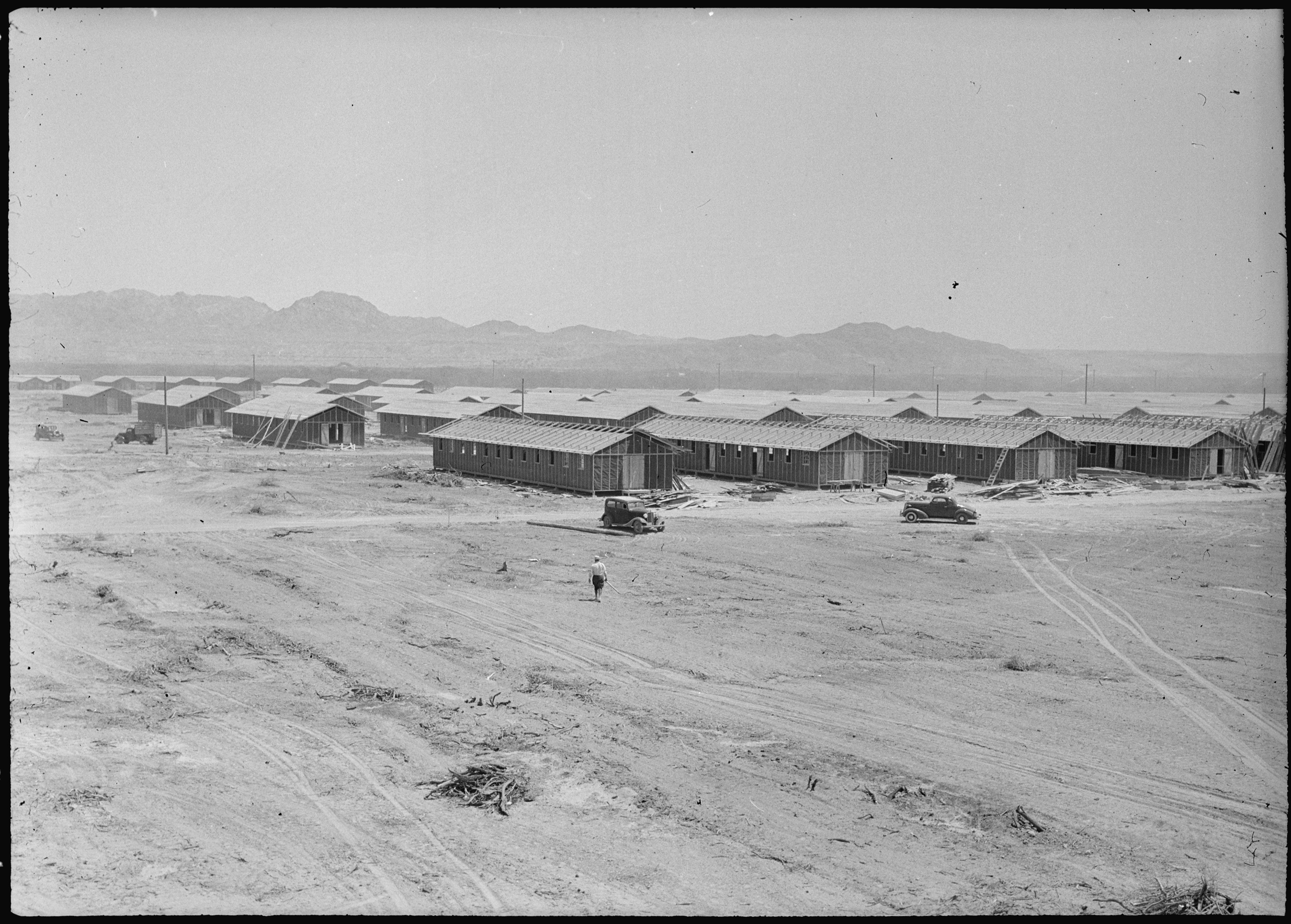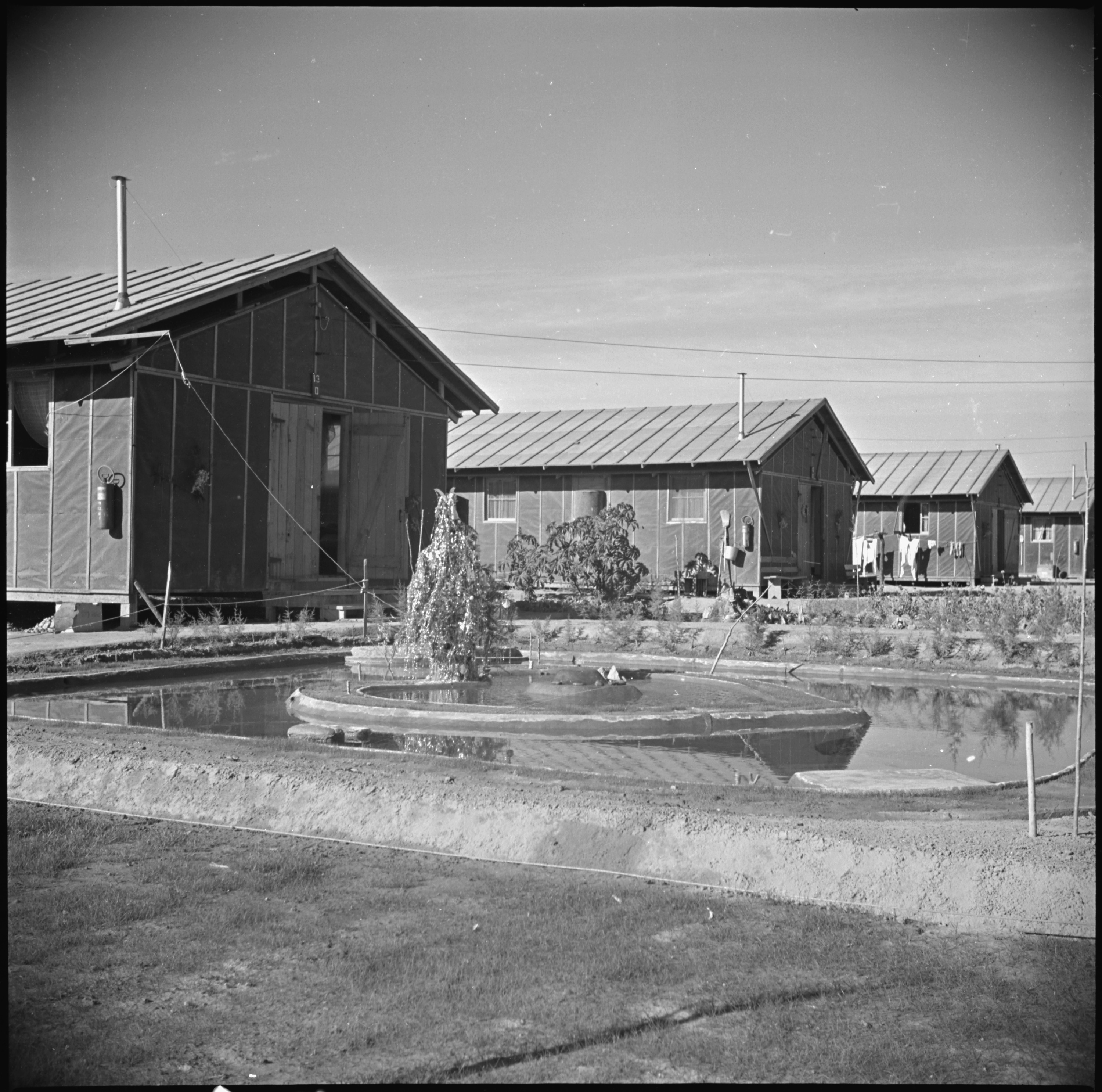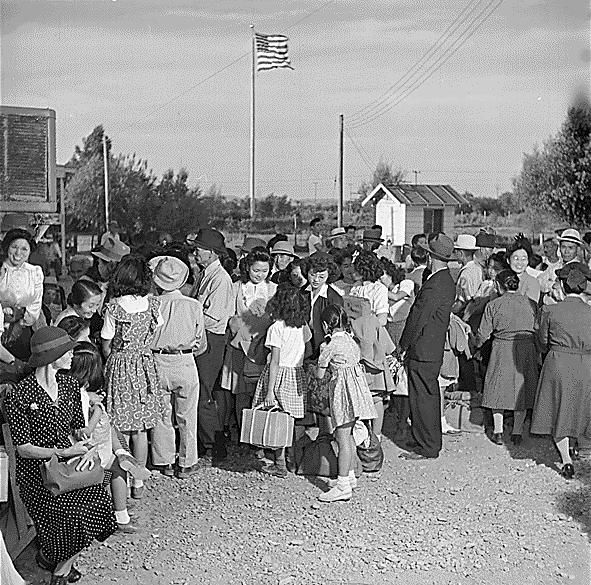Incarceration
The mass incarceration of Japanese and Japanese Americans, most of whom had spent decades or all of their lives in the U.S., was a violent uprooting that scattered many into a diaspora outside of the west coast and spoiled their livelihoods. All were faced with unfair questions about their loyalty to a country that incarcerated them on the basis of race, and a sizable portion were either drafted or volunteered for the military. These interviews make clear that even if the narrators were relatively calm about the past, incarceration was an unjust mechanism for “protecting” the west coast.
The map below is designed to focus on 1940 to 1950, emphasizing how people were uprooted and forced to travel around the U.S. Please make sure to use the time slider function to see just how much people moved.
The text below tries to answer a few questions. How did people respond to incarceration and what were they able to hold onto? Why were some Japanese identified as threats and others not? Did some generations react to incarceration differently? What was camp life like? Where did people go after incarceration? How did people feel about incarceration many years later?
Vulnerability, Loss, and Return
Many accounts show that Japanese were forced to sell their belongings at extremely cheap prices right before incarceration. Orange County people were no different, but if they were lucky enough to keep many of their tools for farming or appliances in their home, it was because they had an arrangement or some long term right to the land they lived on. Still, many returned home to find missing or damaged appliances.

Clarence Nishizu, who would later become a wealthy real estate developer, returned from incarceration with nothing. Because he and his family had not owned their land, they had no right to the land they previously farmed on. Nishizu became a gardener in the San Fernando Valley for a period. Some had several weeks to prepare for incarceration, while others were practically blindsided. According to Roy Taketa, some families were allowed to live outside camps if they had a sponsor on the east side of the Rockies to take them in. Taketa’s aunt in Colorado vouched for them, but they were given a mere four days to depart. So, Taketa’s family sold their things “just like a yard sale now.” (9) The refrigerator and stove that Taketa’s family had saved many months for was sold for about $100. But Taketa described their choice: “It was either give it away or have it stolen, and if you could get a nickel or a dime out of it, you did.”1
Those that owned land tended to be in a better position, farming losses notwithstanding. Henry Akiyama, who owned a goldfish farm, still retained his land by the end of the war. Akiyama employed a couple white people to help with the business, who continued to support the business while Akiyama was incarcerated. However, they faced discrimination for working for a Japanese person, and the manager was drafted, leading to the manager’s wife taking over. In turn, without Akiyama there to maintain the farm, when he returned he said there were only a few goldfish left and many frogs. The Nitta family was well positioned to rebuff the negative effects of incarceration. Their foreman continued to work for them during the war, while bank officials took care of bookkeeping.
Shizu Kamei and her family were less lucky. While the Kamei’s did not own the land, their landlord, a Mr. Souza was generous enough to allow them to keep their hardware and some belongings at a small trailer house on the property in Garden Grove. They were forced to sell their lease to a group of Chinese farmers, and sold off their pickup truck at a sale before evacuation. They retained their icebox and other belongings in their trailer house. Their landlord, Mr. Souza, returned their car when they returned, but they found that their other belongings were either stolen or vandalized. Through a translator, Kamei said that “this is one thing she cannot forget.”2
Racial discrimination did not simply end at the end of the war, but those with deeper roots in the community found ways to get around that discrimination in business. Mitsuo Nitta said that many businesses required cash on delivery after the war and were hesitant to deal with Japanese farmers. In contrast, their connection at California Spray Chemicals “would sneak out at night with some hard-to-get items and pass them on to [Mitsuo’s] father.”3 Mary Nitta, wife of Hitoshi Nitta, also described how their race factored into their life immediately after the war. Their landlord who had typically been friendly, was fearful of being seen with the Nitta family, and put on a cold air. After their return, a group of farmers attempted to intimidate her and her husband, telling them to return to camp. This happened multiple times before they called the sheriff. According to Nitta, the sheriff was slow to react, so they called the War Relocation Authority office which in turn called the office in San Francisco, which contacted the State Attorney General, who then confronted the sheriff. The sheriff’s demeanor immediately changed.
These accounts show that those with land (and wealth) before the war, were more likely to return to Orange County, and therefore be a part of this set of sources. Those with no land and wealth to return to likely left to other places across the U.S. to find a new start or to hope for less discrimination.
Citations
1. Roy Y. Taketa, Interview with Roy Y. Taketa for the Japanese American Project, interview by Mary M. McCarthy, July 13, 1973, 9. 2. Shizu Kamei, Interview with Shizu Kamei for the Japanese American Oral History Project, interview by Toni Rimel, trans. Masako Hanada, January 23, 1984, 64 3. Mitsuo Nitta, Interview with Mitsuo Nitta for the Japanese American Oral History Project, interview by Rolf Janssen, August 12, 1976, 14What Made a Japanese Person a Threat?
After Pearl Harbor, authorities were tasked with not only incarcerating Japanese, but determining their potential threat and separating them according to that threat. While most of the narrators in this collection were sent to Poston, a family incarceration camp in Arizona, there were other camps for “hardcore enemy aliens” as some narrators described it. That typically meant military age men with some sort of perceived allegiance to the Japanese state or association with Japanese culture. That supposed allegiance could take the form of an interest in Japanese martial arts, stock ownership, or having met Japanese officials. One’s status could also change if they protested their incarceration in any form, or if they refused allegiance to the U.S. because of the contradictions between their American citizenship, military service, etc., and their incarceration.
Takeo Yamada resisted volunteering for the military. He asked a military sergeant what his parents were supposed to do if he died in the war, since they were not American citizens, would be ineligible for any social security, and would have no one to help support them. Yamada said that because of this and his participation in Kendo, he was given 4-C status, which meant alien, despite being born in California. Yamada also described a slight difference between how Buddhists and Christians were treated among the incarcerated, saying that “all [the Buddhist] leaders were rounded up."1 Masako Tashima’s husband was incarcerated at a separate detention camp at Tujunga and then New Mexico. At some point he was involved in multiple Japanese Associations or groups, which apparently gave authorities cause for separating him. However, Tashima was careful to point out that her husband was incarcerated with “reverends, schoolteachers, professors, and doctors,” whereas there was a separate group of “rowdies” that were incarcerated elsewhere.2
James Kanno recalled having discussion with kids around his age in the first months after being incarcerated. They were upset and angry, but “even so, America was our country, and this was the only country we knew."3 In the first year, Kanno says that everyone received a questionnaire asking whether they would pledge allegiance to the U.S. and whether they would serve Japan in the military. One of the common refrains was, “well, I would pledge allegiance to the United States, but I might fight for Japan because of this evacuation.”4
Kiyoshi Shigekawa and his wife were both accused of connections to the Japanese state. Mrs. Shigekawa, while studying pharmacology at USC, met a visiting Japanese Navy officer through one of her professors. The “mistake” that caused so much trouble for them was a simple photo of that meeting, which the Shigekawa’s agreed caused investigators to attempt to incriminate them for many things. Eventually Mr. Shigekawa became chief of police at Poston and also participated in a case suing the U.S. government for the legality of their incarceration. George Fujii described how authorities found out about his stock purchases and participation in Judo. Fujii’s father had bought stock in a Manchurian company under his name. Fujii himself had bought stock in Tokyo Electric and Taiwan Sugar, among others. As a result, his father was incarcerated in a separate camp. But as Fujii describes it, this was not easily acquired information, meaning that someone had informed the FBI about this connection. Fujii was looked at with further suspicion especially because he participated in Judo at the Poston Dojo.
Yoshiki Yoshida, a particularly colorful and open narrator was insistent that despite practicing Japanese martial arts, that did not mean he—or anyone else—was participating in Japanese state worship. Yoshida began learning Kendo when he lived in Chula Vista, CA, and rather than emperor worship, “Yamato damashii [the Japanese spirit],” or anything else, Yoshida insisted that they learned “the Japanese tradition of being a man and being able to tolerate things, plus being able to distinguish between right and wrong.”5 Yoshida attributes many people’s detention in enemy alien camps to their interest in martial arts: “Due to the fact that a lot of the first-generation people who were involved in Kendo—with the conception that they were Japanese-emperor-military type of gung ho people—these people were the first ones to get picked up after Pearl harbor."6 In fact, Yoshida says that his father was incarcerated because of Yoshida’s participation in Kendo.
Curiously, Clarence Nishizu, who was very active in Japanese martial arts and had toured the Japanese Empire in the early 1930s, meeting a variety of high-ranking officials, did not mention that he came under suspicion for these connections. This begs the question of how arbitrary or blundering investigators were at establishing linkages of “Japaneseness” and therefore suspiciousness, as well as whether other factors may have made other narrators suspicious to investigators. Without official documents, we are left with a similar sense of bewilderment that the incarcerated likely felt.
Citations
1. Takeo Yamada, Interview With Takeo Yamada for the Japanese American Oral History Project, interview by Pat Morgan, March 26, 1973, 17. 2. Masako Tashima and Mary Tashima, Interview with Masako Tashima for the Japanese American Oral History Project, interview by Pat Tashima, June 1, 1974, 5–7 3. James Kanno, Interview with James Kanno for the Japanese American Project, interview by John McFarlane, April 26, 1971, 13 4. Ibid. 5. Yoshiki Yoshida, Interview With Yoshiki Yoshida for the Japanese American Oral History Project, interview by Alice Maxwell, trans. Yukiko Sato, November 19, 1983, 3 6. Ibid.The Troublesome Kibei
As there were cleavages between Kibei and other generations of Japanese in America, so too there were cleavages between these groups while incarcerated. In general, narrators tended to agree that the Kibei were far more resistant and critical of incarceration, which seemed to present a lot of uncomfortable situations throughout the camps.

According to Takeo Yamada, the Kibei “felt they were American like anybody else—although they were more faithful to Japan….They were the ones that were causing quite a few troubles in camp.” 1 Although, in Yamada’s telling, while they caused discomfort with their demands, they appeared to be the ones agitating for valuable changes. For example, many of the narrators note that in the first weeks at Poston, they were served sauerkraut and sausage, which many Japanese described as unpalatable. In response, Kibei demanded a change immediately. They “got involved and [were] very blunt about anything they want to say.” 2 Interestingly, Yamada also said that the Kibei ran the police force until later on.
But despite Kibei in general agitating more frequently and severely, authorities were also forced to rely on them because of their language skills. As George Fujii, a Kibei himself, describes, they were frequently given administrative or translation jobs while incarcerated. Fujii implies that this also led to Kibei becoming somewhat drunk with their power in the administration: “Some of the Japanese, especially the Kibei, tried to show their strength by being connected with the administration.”3 But Fujii blames the Kibei for some of the unrest in the camp in a different way than Yamada. Because of the Kibei's sometimes poor translation and interpretation of authorities’ orders, this resulted in different kinds of friction and conflict in the camp. While Fujii being arrested in camp on seemingly bogus grounds may have helped cause a strike in Poston, he actually attributes the gap between what people understood and what the authorities were communicating to the poor work of the Kibei, leading to the unrest.
Citations
1. Yamada, Interview With Takeo Yamada for the Japanese American Oral History Project, 15 2. Yamada, Interview With Takeo Yamada for the Japanese American Oral History Project, 16 3. George Fujii, Interview with George Fujii for the Japanese American Project, interview by Ronald C. Larson and Russell Nowell, August 31, 1976, 83.Insufficiency in Camps and Sears Roebuck
Of all the things that appeared in these oral histories, perhaps the most novel and unexpected was how many times narrators mentioned Sears Roebuck. The camps were almost entirely unfurnished. Housing at Poston had been hastily and cheaply built, so that neighbors could see into each others’ dwellings, to say nothing of hearing one another. The problem extended to furniture and clothing—it was simply rudimentary at best. Internees turned to mail ordering from places like Sears Roebuck.
In the wintertime, Clarence Nishizu described how the army and navy clothing they were issued was not enough to keep out the cold at Heart Mountain in Wyoming. So, Nishizu ordered a sheepskin coat from either the Montgomery Ward or Sears Roebuck catalog. Henry Kanegae says that he too ordered from the Sears Roebuck or Montgomery Ward catalog. Hitoshi Nitta was another that described ordering extra clothing while at Poston, since the camp canteen did not always sell what they needed.
Diaspora: East Coast, Japan, and Return
One characteristic of World War Two in Europe was the extreme volume of population transfer that occurred throughout Nazi occupied lands. After the war, Jews scattered into diaspora from the U.S. to Israel. While the aims of the incarcerating authority and their methods were very different, it is useful to think of Japanese incarceration as part of the wider wartime population transfers and postwar diaspora of World War Two. While many of the narrators of this project returned to Orange County and Southern California because they had assets in the area, a significant portion of those incarcerated dispersed across the U.S., and a small group returned to Japan.
Yoshiki Yoshida, who had lived on the Irvine Ranch and in northern San Diego county, initially moved to the east coast somewhere, working in a factory. This was short-lived, and Yoshida moved to Los Angeles in 1946. Yoshiyuki Tashima even described a difference in mentality among the Japanese. After incarceration, people “relocated to Denver, to Chicago, to New York, to Cleveland, all over the United States,” and “mingled” with other people compared to being more isolated before.1 Like Tashima, Minoru Nitta noticed how widely Japanese spread across the U.S. Although Nitta says that most returned to California, he directly attributes the spread of Japanese across the U.S., particularly mentioning Cleveland and Chicago, to incarceration. Charles Ishii echoes what Nitta says, mentioning the east coast and Colorado as places that people departed to.
A small group returned to Japan after the war. Mine Yabuki Kaneko returned to Japan with her husband, Hyotaro. However, immediately upon arriving in Japan in 1946, Mine realized that conditions were extremely difficult to the point that people were collecting driftwood. She and Hyotaro spent the next decade in her home village, Torikawa, in Fukushima. In fact, a small group of people may have returned to Japan during the war as well. Amy Uno Ishii’s father was detained the day of Pearl Harbor, but seemingly had few of the connections that would make him a suspect Japanese citizen, other than being an adult male. Ishii even describes how she and each individual in her family were repeatedly questioned, searching for a reason to keep her father detained. Ishii’s father was imprisoned in multiple so-called “enemy alien” camps. According to Ishii, the authorities attempted to deport him to Japan multiple times, but he refused at the port, exclaiming that his family was incarcerated in the U.S., and that his sons were serving in the military. This happened each time that he was transferred between camps, from Fort Missoula to Lordsburg, to Santa Fe, and Bismarck, North Dakota. Eventually Ishii was reunited with her father in Crystal City, Texas, a family camp in which the men were considered suspicious.
Citations
1. Yoshiyuki Tashima, Interview with Yoshiyuki Tashima for the Japanese American Oral History Project, interview by Pat Tashima, February 20, 1974, 4.In Retrospect: Restitution, Anger, and Optimism
The experience of incarceration profoundly disrupted lives and produced a great deal of conflict even among the incarcerated themselves, but each narrator’s feelings towards incarceration and its products were different. They were not all critical of what happened between 1941 and 1945, and some even argued positives came out of their incarceration. Others were ambivalent about the law to compensate those who had been incarcerated. And still others remembered mostly fear and uncertainty.
James Kanno believed that part of the reason incarceration took place was because of “economic pressure.”1 Kanno said that a large percentage of acreage was farmed by the Japanese around Orange County and that much of the produce handled at, for example, the Los Angeles wholesale market, was handled by Japanese. Moreover, many Japanese participated in the fishing industry around Terminal Island. As Kanno put it, “I think possibly too strong a competition in some areas didn’t help.”2 In other words, he suggested that Japanese were incarcerated partially to alleviate economic discontent among white voters by freeing profitable farmland.

Mas Uyesugi, who was incarcerated and then drafted after departing camp during the war, was highly critical of the ordeal. “Well, I think the more one thinks about it, the more upset one gets about it, really.” He pointed to the hypocrisy in people from other Axis power countries not being incarcerated, suggesting that they were “equally dangerous.” Still, Uyesugi felt that holding onto a grudge would be unhelpful, so that rather than hold a grudge or “feel sorry for ourselves,” he believed in exposing and facing those injustices to learn from them. Uyesugi continued to describe how racial relations had shifted from the 1940s through the date of his interview in 1971. In the 1940s, he suggested that the white community did not care much about a “small segment of Oriental people living in America” and attributes the wide discrimination to a lack of understanding. But in his mind, there still remained traces of that same discriminatory attitude. Uyesugi took issue with the phrases “Well, I’m not yellow” and “I don’t have a yellow streak down my back,” explaining that there is no question how many Japanese gave their life in the war. He said that such slurs should be removed from their collective vocabulary.3
Mary Nitta, who met and married Hitoshi Nitta while in Poston, had quite a positive view of evacuation at the time of her interview in 1972. For her parents and the Issei generation, Nitta thought that this was the first time that they could “take it easy,” since for farming families, they were working many hours a day, every day a week, and never vacationing. While incarcerated, everyone was given a job for eight hours a day, five days per week, and in Nitta’s mind, the result was that many were able to take up hobbies like drama, poetry, literature, and English. As Nitta put it, many lost their assets and lost materially from incarceration, but gained spiritually. Nitta herself felt that she learned how to get along with others, because she was living among other Japanese people in close quarters for the first time in her life. She even says that she made many close relationships while incarcerated that had lasted for decades beyond—including with white camp personnel. Although, to be sure, Nitta admits that had her and Hitoshi’s lives not turned out so prosperous, and had her life not been without anguish after the war, she may have been more “bitter.” 4
Yoshiki Yoshida, born in Huntington Beach, was critical of the possibility of reparations for incarceration at the time of his interview in 1983. At that time, the possibility of reparations for Japanese incarcerated was being discussed on a national scale, and Yoshida believed that this discussion had “hurt the Japanese people in the eyes of the American people.” His perspective in general was that it should not be discussed, because the money itself would be less helpful than the harm to “good will…between the Japanese community and the American community.” He suggested that there might be no end to such policies if the Japanese people asked for reparations. Moreover, Yoshida suggested that by the time Congress actually appropriated the money, no one would be around to accept it. Still, if the money was appropriated, Yoshida admitted that he would accept it. 5
